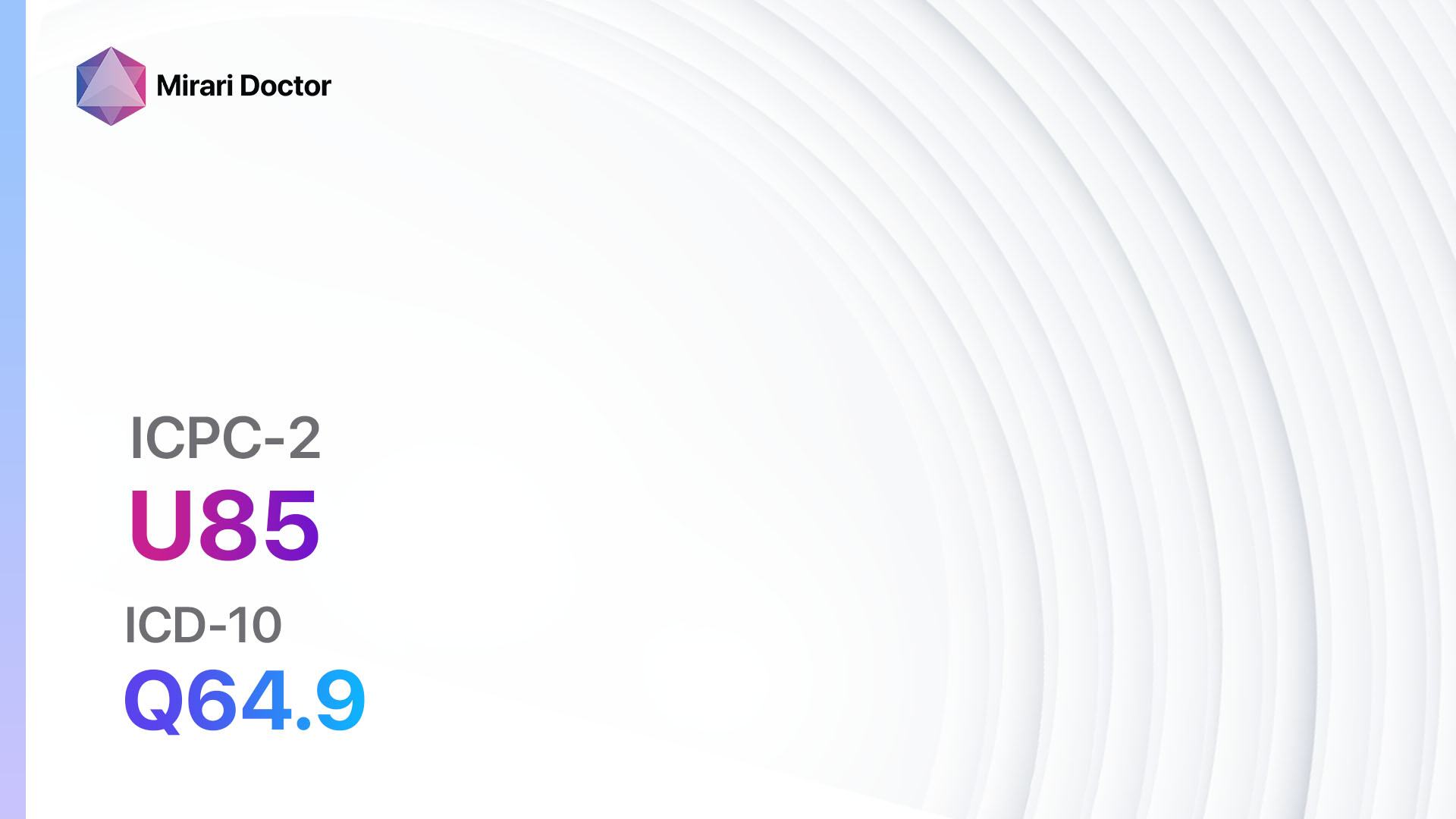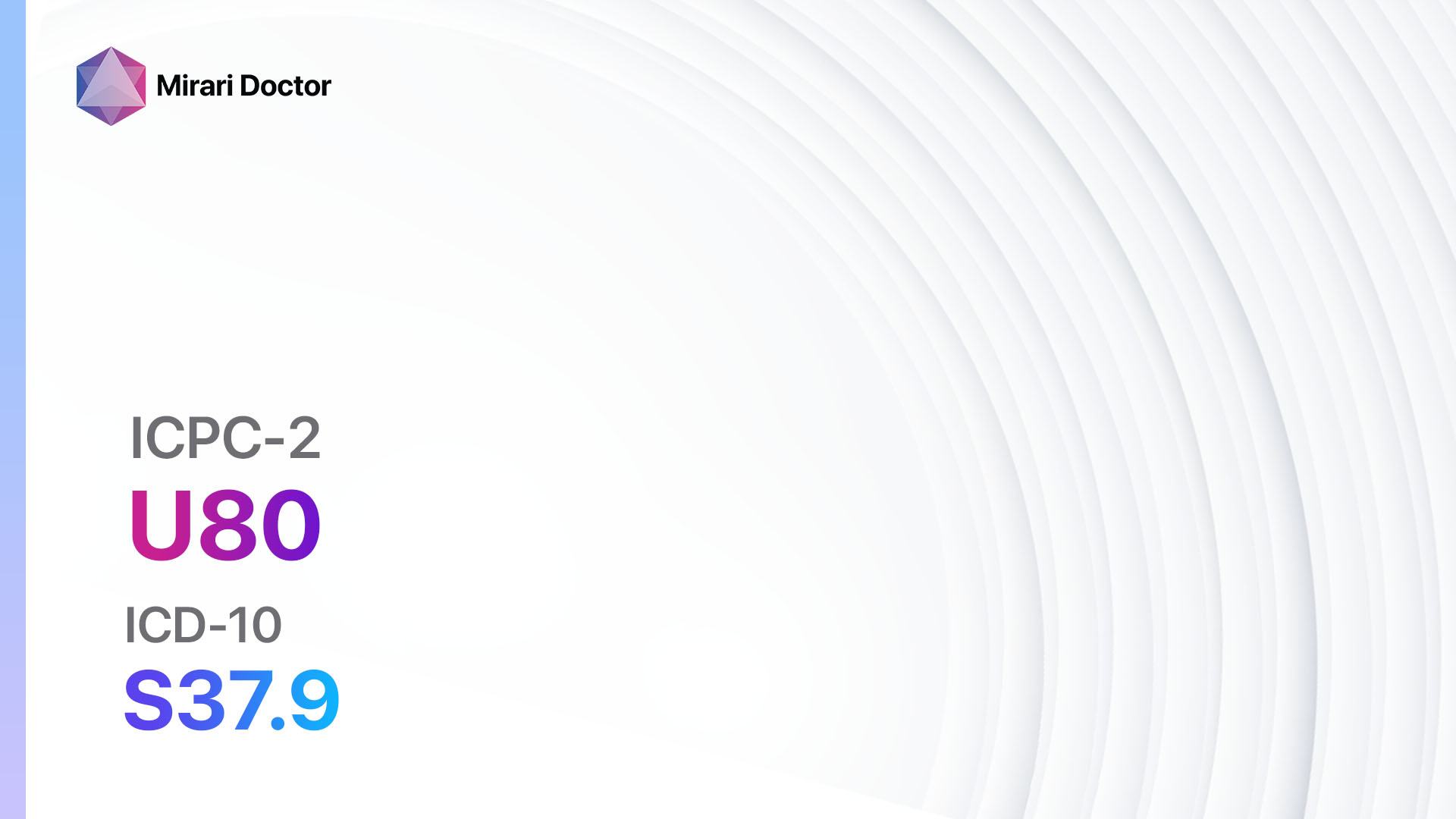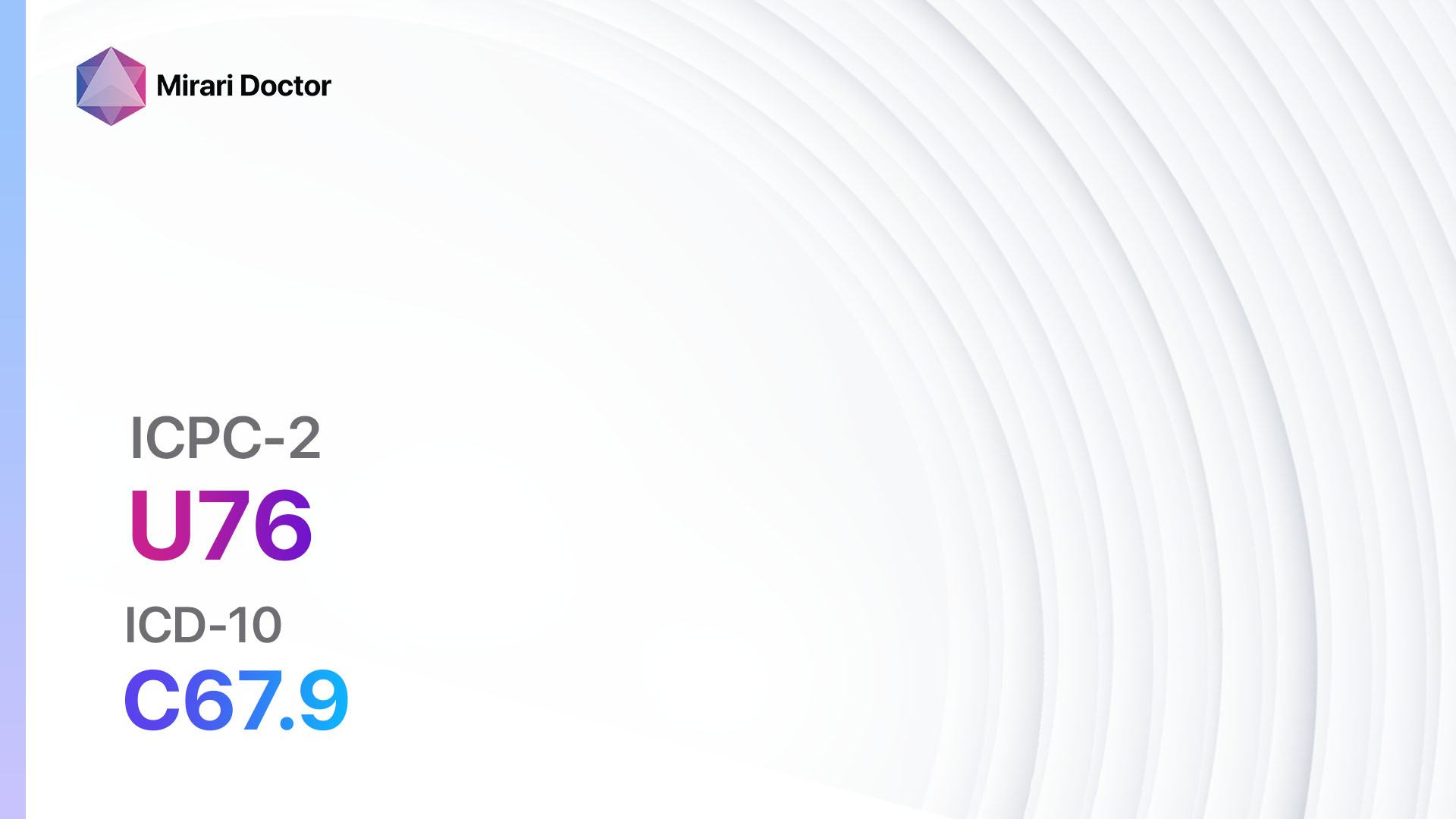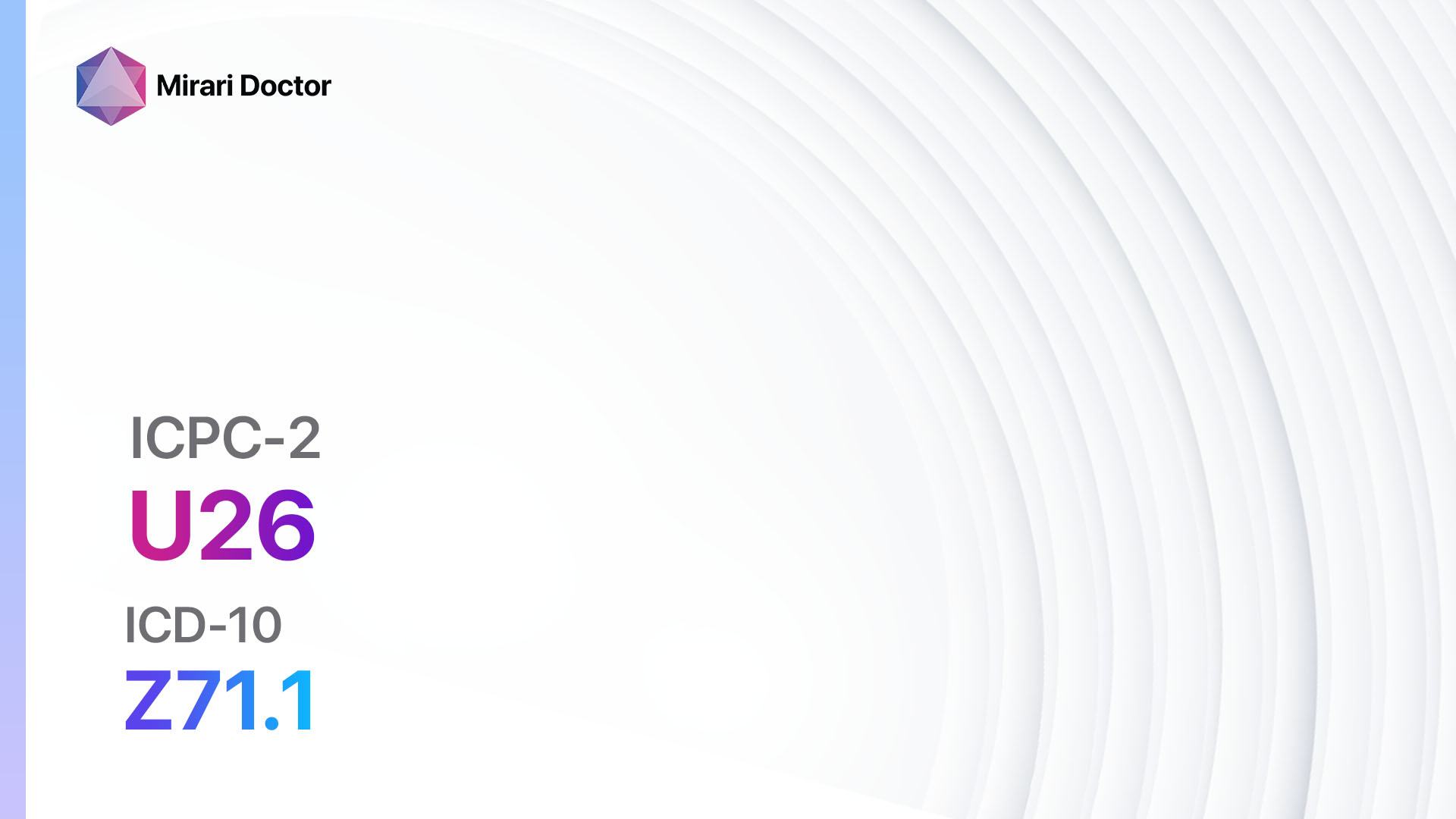
Introduction
Fear of urinary disease other (ICPC-2: U27) refers to the anxiety or fear experienced by individuals related to the possibility of having a urinary disease that does not fall under any specific category. This fear can be distressing and may lead to avoidance of medical care or unnecessary worry[1]. The aim of this guide is to provide healthcare professionals with a comprehensive approach to diagnosing and managing fear of urinary disease other.
Codes
- ICPC-2 Code: U27 Fear of urinary disease other
- ICD-10 Code: Z71.1 Person with feared complaint in whom no diagnosis is made[2]
Symptoms
- Frequent urination: The individual may feel the need to urinate more often than usual.
- Urgency: There may be a sudden and strong urge to urinate.
- Pain or discomfort during urination: The individual may experience pain, burning, or discomfort while urinating.
- Blood in urine: Hematuria, or the presence of blood in the urine, may be a symptom of urinary disease.
- Lower abdominal pain: The individual may experience pain or discomfort in the lower abdomen[3].
Causes
The fear of urinary disease other can be caused by various factors, including:
- Previous traumatic experiences related to urinary diseases.
- Family history of urinary diseases.
- Misinformation or lack of knowledge about urinary diseases.
- Anxiety or fear related to medical procedures or examinations[4].
Diagnostic Steps
Medical History
- Gather information about the patient’s symptoms, including the frequency and severity.
- Ask about any previous urinary diseases or related medical conditions.
- Inquire about any family history of urinary diseases.
- Assess the patient’s knowledge and beliefs about urinary diseases.
- Evaluate the patient’s anxiety or fear levels related to medical procedures or examinations[5].
Physical Examination
- Perform a thorough physical examination, including a general examination of the patient’s overall health.
- Focus on specific signs or findings that may indicate a urinary disease, such as tenderness in the lower abdomen or abnormal urine color[6].
Laboratory Tests
- Urinalysis: Analyze a urine sample to check for the presence of blood, infection, or other abnormalities.
- Blood tests: Measure kidney function and check for any signs of inflammation or infection.
- Culture and sensitivity test: If a urinary tract infection is suspected, a urine sample may be sent for culture to identify the specific bacteria causing the infection and determine the most effective antibiotic treatment[7].
Diagnostic Imaging
- Ultrasound: Use ultrasound imaging to visualize the urinary tract and assess the structure and function of the kidneys, bladder, and ureters.
- CT scan: Provide detailed images of the urinary tract to detect any abnormalities or blockages.
- MRI: Use magnetic resonance imaging to obtain high-resolution images of the urinary system, allowing for better visualization of structures and potential abnormalities[8].
Other Tests
- Cystoscopy: Insert a thin tube with a camera into the urethra and bladder to visualize the interior of the urinary tract and identify any abnormalities.
- Urodynamic testing: Evaluate the function of the bladder and urethra by measuring pressure changes during filling and emptying of the bladder.
- Biopsy: If a suspicious mass or lesion is found, a small tissue sample may be taken for further examination under a microscope[9].
Follow-up and Patient Education
- Schedule follow-up appointments to review test results and discuss further management.
- Provide education and reassurance to the patient about their condition and the steps taken to diagnose and manage it.
- Address any concerns or fears the patient may have and provide appropriate resources or referrals for additional support if needed[10].
Possible Interventions
Traditional Interventions
Medications:
Top 5 drugs for fear of urinary disease other:
- Anxiolytics (e.g., Alprazolam, Diazepam, Lorazepam):
- Cost: Generic versions can range from $3 to $50 per month.
- Contraindications: Hypersensitivity, acute narrow-angle glaucoma.
- Side effects: Drowsiness, dizziness, confusion.
- Severe side effects: Respiratory depression, paradoxical reactions.
- Drug interactions: Alcohol, opioids, other central nervous system depressants.
- Warning: Risk of dependence and withdrawal symptoms with long-term use.
- Selective serotonin reuptake inhibitors (SSRIs) (e.g., Sertraline, Fluoxetine, Escitalopram):
- Cost: Generic versions can range from $10 to $50 per month.
- Contraindications: Hypersensitivity, concomitant use with monoamine oxidase inhibitors (MAOIs).
- Side effects: Nausea, headache, sexual dysfunction.
- Severe side effects: Serotonin syndrome, suicidal thoughts.
- Drug interactions: MAOIs, other serotonergic drugs.
- Warning: Increased risk of suicidal thoughts in young adults.
- Beta-blockers (e.g., Propranolol, Atenolol, Metoprolol):
- Cost: Generic versions can range from $10 to $30 per month.
- Contraindications: Severe bradycardia, heart block, uncontrolled heart failure.
- Side effects: Fatigue, dizziness, bradycardia.
- Severe side effects: Bronchospasm, heart block.
- Drug interactions: Calcium channel blockers, insulin.
- Warning: Should not be abruptly stopped.
- Antidepressants (e.g., Amitriptyline, Nortriptyline, Imipramine):
- Cost: Generic versions can range from $10 to $50 per month.
- Contraindications: Hypersensitivity, concomitant use with MAOIs.
- Side effects: Dry mouth, constipation, sedation.
- Severe side effects: Cardiac arrhythmias, seizures.
- Drug interactions: MAOIs, other serotonergic drugs.
- Warning: Increased risk of suicidal thoughts in young adults.
- Antipsychotics (e.g., Quetiapine, Risperidone, Olanzapine):
- Cost: Generic versions can range from $10 to $50 per month.
- Contraindications: Hypersensitivity, dementia-related psychosis.
- Side effects: Sedation, weight gain, extrapyramidal symptoms.
- Severe side effects: Neuroleptic malignant syndrome, tardive dyskinesia.
- Drug interactions: Other antipsychotics, QT-prolonging drugs.
- Warning: Increased risk of mortality in elderly patients with dementia-related psychosis.
Alternative Drugs:
- Herbal supplements: Some herbal supplements, such as valerian root or passionflower, may have calming effects and help reduce anxiety. Cost: Varies depending on the specific supplement.
- Cognitive-behavioral therapy (CBT): A form of psychotherapy that helps individuals identify and change negative thought patterns and behaviors. Cost: Varies depending on the therapist and location.
- Support groups: Joining a support group with individuals who have similar fears or experiences can provide emotional support and coping strategies. Cost: Varies depending on the organization or group.
Surgical Procedures:
- No surgical procedures are indicated for the management of fear of urinary disease other.
Alternative Interventions
- Relaxation techniques: Deep breathing exercises, progressive muscle relaxation, or guided imagery can help reduce anxiety and promote relaxation. Cost: Free or minimal cost for instructional materials or classes.
- Mindfulness meditation: Practicing mindfulness meditation can help individuals become more aware of their thoughts and emotions, reducing anxiety and fear. Cost: Free or minimal cost for instructional materials or classes.
- Yoga: Yoga combines physical postures, breathing exercises, and meditation to promote relaxation and reduce stress. Cost: Varies depending on the location and type of class, ranging from $10 to $20 per session.
- Acupuncture: May help reduce anxiety and promote relaxation. Cost: $60 to $120 per session.
- Counseling or therapy: Working with a therapist or counselor can help individuals address and overcome their fears and anxieties. Cost: Varies depending on the therapist and location.
Lifestyle Interventions
- Education and reassurance: Providing accurate information about urinary diseases and addressing any misconceptions can help alleviate fears and anxiety. Cost: Free or minimal cost for educational materials.
- Regular exercise: Engaging in regular physical activity can help reduce anxiety and improve overall well-being. Cost: Varies depending on the type of exercise, ranging from free activities like walking or jogging to gym memberships.
- Stress management techniques: Practicing stress management techniques, such as deep breathing exercises, journaling, or engaging in hobbies, can help individuals cope with anxiety and fear. Cost: Free or minimal cost for instructional materials or classes.
- Healthy diet: Eating a balanced diet rich in fruits, vegetables, whole grains, and lean proteins can support overall health and well-being. Cost: Varies depending on individual food choices and preferences.
- Avoidance of triggers: Identifying and avoiding situations or triggers that exacerbate fear or anxiety can help manage symptoms. Cost: Free.
It is important to note that the cost ranges provided are approximate and may vary depending on the location and availability of the interventions.
Mirari Cold Plasma Alternative Intervention
Understanding Mirari Cold Plasma
- Safe and Non-Invasive Treatment: Mirari Cold Plasma is a safe and non-invasive treatment option for various skin conditions. It does not require incisions, minimizing the risk of scarring, bleeding, or tissue damage.
- Efficient Extraction of Foreign Bodies: Mirari Cold Plasma facilitates the removal of foreign bodies from the skin by degrading and dissociating organic matter, allowing easier access and extraction.
- Pain Reduction and Comfort: Mirari Cold Plasma has a local analgesic effect, providing pain relief during the treatment, making it more comfortable for the patient.
- Reduced Risk of Infection: Mirari Cold Plasma has antimicrobial properties, effectively killing bacteria and reducing the risk of infection.
- Accelerated Healing and Minimal Scarring: Mirari Cold Plasma stimulates wound healing and tissue regeneration, reducing healing time and minimizing the formation of scars.
Mirari Cold Plasma Prescription
Video instructions for using Mirari Cold Plasma Device – U27 Fear of urinary disease other (ICD-10:Z71.1)
| Mild | Moderate | Severe |
| Mode setting: 1 (Infection) Location: 2 (Prostate & Uterus) Morning: 15 minutes, Evening: 15 minutes |
Mode setting: 1 (Infection) Location: 2 (Prostate & Uterus) Morning: 30 minutes, Lunch: 30 minutes, Evening: 30 minutes |
Mode setting: 1 (Infection) Location: 2 (Prostate & Uterus) Morning: 30 minutes, Lunch: 30 minutes, Evening: 30 minutes |
| Mode setting: 6 (Liver/Kidney Therapy) Location: 2 (Prostate & Uterus) Morning: 15 minutes, Evening: 15 minutes |
Mode setting: 6 (Liver/Kidney Therapy) Location: 2 (Prostate & Uterus) Morning: 30 minutes, Lunch: 30 minutes, Evening: 30 minutes |
Mode setting: 6 (Liver/Kidney Therapy) Location: 2 (Prostate & Uterus) Morning: 30 minutes, Lunch: 30 minutes, Evening: 30 minutes |
| Mode setting: 6 (Liver/Kidney Therapy) Location: 3 (Kidney, Liver & Spleen) Morning: 15 minutes, Evening: 15 minutes |
Mode setting: 6 (Liver/Kidney Therapy) Location: 3 (Kidney, Liver & Spleen) Morning: 30 minutes, Lunch: 30 minutes, Evening: 30 minutes |
Mode setting: 6 (Liver/Kidney Therapy) Location: 3 (Kidney, Liver & Spleen) Morning: 30 minutes, Lunch: 30 minutes, Evening: 30 minutes |
| Mode setting: 7 (Immunotherapy) Location: 1 (Sacrum) Morning: 15 minutes, Evening: 15 minutes |
Mode setting:7 (Immunotherapy) Location: 1 (Sacrum) Morning: 30 minutes, Lunch: 30 minutes, Evening: 30 minutes |
Mode setting:7 (Immunotherapy) Location: 1 (Sacrum) Morning: 30 minutes, Lunch: 30 minutes, Evening: 30 minutes |
| Total Morning: 60 minutes approx. $10 USD, Evening: 60 minutes approx. $10 USD |
Total Morning: 120 minutes approx. $20 USD, Lunch: 120 minutes approx. $20 USD, Evening: 120 minutes approx. $20 USD, |
Total Morning: 120 minutes approx. $20 USD, Lunch: 120 minutes approx. $20 USD, Evening: 120 minutes approx. $20 USD, |
| Usual treatment for 7-60 days approx. $140 USD – $1200 USD | Usual treatment for 6-8 weeks approx. $2,520 USD – $3,360 USD |
Usual treatment for 3-6 months approx. $5,400 USD – $10,800 USD
|
 |
|
Use the Mirari Cold Plasma device to treat Fear of urinary disease other effectively.
WARNING: MIRARI COLD PLASMA IS DESIGNED FOR THE HUMAN BODY WITHOUT ANY ARTIFICIAL OR THIRD PARTY PRODUCTS. USE OF OTHER PRODUCTS IN COMBINATION WITH MIRARI COLD PLASMA MAY CAUSE UNPREDICTABLE EFFECTS, HARM OR INJURY. PLEASE CONSULT A MEDICAL PROFESSIONAL BEFORE COMBINING ANY OTHER PRODUCTS WITH USE OF MIRARI.
Step 1: Cleanse the Skin
- Start by cleaning the affected area of the skin with a gentle cleanser or mild soap and water. Gently pat the area dry with a clean towel.
Step 2: Prepare the Mirari Cold Plasma device
- Ensure that the Mirari Cold Plasma device is fully charged or has fresh batteries as per the manufacturer’s instructions. Make sure the device is clean and in good working condition.
- Switch on the Mirari device using the power button or by following the specific instructions provided with the device.
- Some Mirari devices may have adjustable settings for intensity or treatment duration. Follow the manufacturer’s instructions to select the appropriate settings based on your needs and the recommended guidelines.
Step 3: Apply the Device
- Place the Mirari device in direct contact with the affected area of the skin. Gently glide or hold the device over the skin surface, ensuring even coverage of the area experiencing.
- Slowly move the Mirari device in a circular motion or follow a specific pattern as indicated in the user manual. This helps ensure thorough treatment coverage.
Step 4: Monitor and Assess:
- Keep track of your progress and evaluate the effectiveness of the Mirari device in managing your Fear of urinary disease other. If you have any concerns or notice any adverse reactions, consult with your health care professional.
Note
This guide is for informational purposes only and should not replace the advice of a medical professional. Always consult with your healthcare provider or a qualified medical professional for personal advice, diagnosis, or treatment. Do not solely rely on the information presented here for decisions about your health. Use of this information is at your own risk. The authors of this guide, nor any associated entities or platforms, are not responsible for any potential adverse effects or outcomes based on the content.
Mirari Cold Plasma System Disclaimer
- Purpose: The Mirari Cold Plasma System is a Class 2 medical device designed for use by trained healthcare professionals. It is registered for use in Thailand and Vietnam. It is not intended for use outside of these locations.
- Informational Use: The content and information provided with the device are for educational and informational purposes only. They are not a substitute for professional medical advice or care.
- Variable Outcomes: While the device is approved for specific uses, individual outcomes can differ. We do not assert or guarantee specific medical outcomes.
- Consultation: Prior to utilizing the device or making decisions based on its content, it is essential to consult with a Certified Mirari Tele-Therapist and your medical healthcare provider regarding specific protocols.
- Liability: By using this device, users are acknowledging and accepting all potential risks. Neither the manufacturer nor the distributor will be held accountable for any adverse reactions, injuries, or damages stemming from its use.
- Geographical Availability: This device has received approval for designated purposes by the Thai and Vietnam FDA. As of now, outside of Thailand and Vietnam, the Mirari Cold Plasma System is not available for purchase or use.
References
- Crist JV, Grunfeld EA. Factors reported to influence fear of recurrence in cancer patients: a systematic review. Psychooncology. 2013;22(5):978-986.
- World Health Organization. (2019). International Statistical Classification of Diseases and Related Health Problems (ICD-10).
- Mayo Clinic. (2021). Urinary tract infection (UTI) – Symptoms and causes. Retrieved from https://www.mayoclinic.org/diseases-conditions/urinary-tract-infection/symptoms-causes/syc-20353447
- Lukacz ES, Santiago-Lastra Y, Albo ME, Brubaker L. Urinary Incontinence in Women: A Review. JAMA. 2017;318(16):1592-1604.
- Coyne KS, Sexton CC, Thompson CL, et al. The prevalence of lower urinary tract symptoms (LUTS) in the USA, the UK and Sweden: results from the Epidemiology of LUTS (EpiLUTS) study. BJU Int. 2009;104(3):352-360.
- Chapple CR, Wein AJ, Abrams P, et al. Lower urinary tract symptoms revisited: a broader clinical perspective. Eur Urol. 2008;54(3):563-569.
- Schaeffer AJ, Schaeffer EM. Infections of the urinary tract. In: Wein AJ, Kavoussi LR, Partin AW, Peters CA, eds. Campbell-Walsh Urology. 11th ed. Philadelphia, PA: Elsevier; 2016:chap 12.
- Moloney F, Murphy KP, Twomey M, et al. Haematuria: An Imaging Guide. Adv Urol. 2014;2014:414125.
- Nitti VW. Pressure flow urodynamic studies: the gold standard for diagnosing bladder outlet obstruction. Rev Urol. 2005;7 Suppl 6(Suppl 6):S14-S21.
- Gormley EA, Lightner DJ, Burgio KL, et al. Diagnosis and treatment of overactive bladder (non-neurogenic) in adults: AUA/SUFU guideline. J Urol. 2012;188(6 Suppl):2455-2463.
Related articles
Made in USA



























